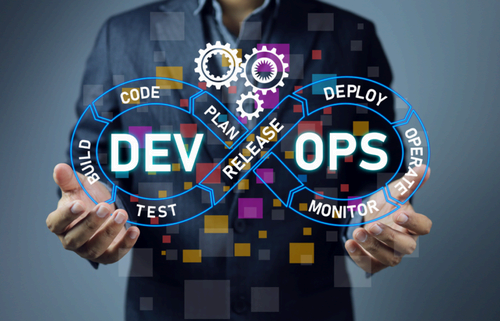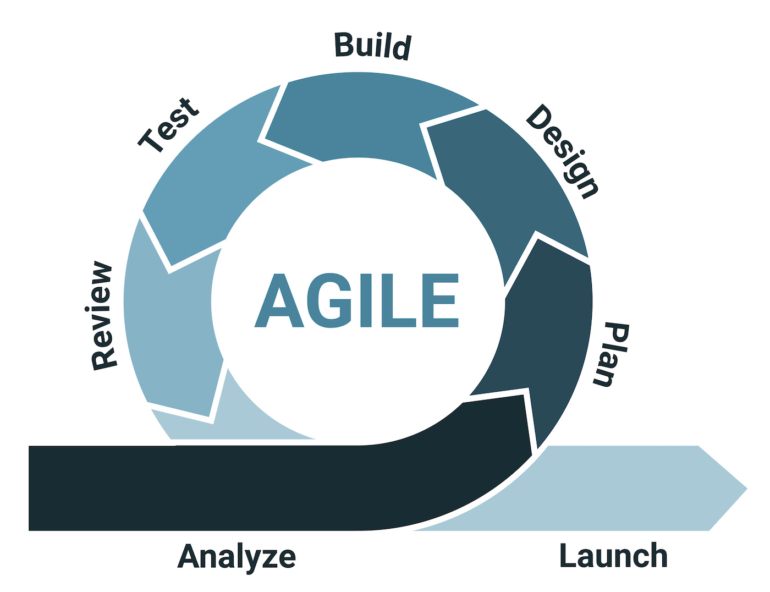DevOps and Agile are methodologies that are facilitating advanced software development across the world. DevOps enhances collaboration between software development and IT operations teams, while Agile enhances developer and development cycle efficiency.
While DevOps and Agile differ in many ways, they also have many similarities that allow them to complement one another. This guide will offer a detailed breakdown of the similarities and differences between the DevOps and Agile methodologies.
Jump to:
What is DevOps?
DevOps is a methodology that brings together an organization’s software development and IT operations teams to encourage collaboration and boost productivity. By integrating people, practices, processes, technologies and tools, DevOps lets teams relish automated and robust code deployment, as well as increased transparency.
DevOps’ primary goal is the continuous delivery of high-quality software. As such, its principles are based on continuous development, integration, testing, deployment, feedback, monitoring and operations. DevOps teams build, evaluate, deploy and monitor on an ongoing basis, unlike traditional software development methods. This change and focus on continuity result in faster deployments that are also reliable and easily integrated. And since DevOps relies heavily on automation, the methodology also increases speed and product quality.
You can learn more about DevOps culture and practices by reading our guide to DevOps.

What is Agile?
Agile is a methodology that follows an iterative approach to software development and project management. It emphasizes collaboration and communication between cross-functional teams to overcome problems and allow quicker releases to face deadlines. Agile also emphasizes customer feedback to boost product quality.
In Agile, larger processes are broken down into smaller units (sprints). These sprints often last between two and four weeks. The methodology focuses on each sprint’s incremental deployments and integrates them for final testing.
Agile’s core values begin with valuing individuals over tools and processes and having the right team of people work together to overcome problems and preserve a healthy work environment. This methodology prioritizes software delivery to customers over spending a ton of time on extensive documentation. Continuous collaboration and development with customers versus focusing on contract negotiation is another Agile core value, as is being flexible and adapting to changes on the fly.
You can learn more by reading our tutorial: What is Agile?

DevOps and Agile similarities
The DevOps and Agile methodologies have several similarities. This is not surprising, as DevOps was created to fill in some missing gaps in the Agile methodology, and the Agile manifesto includes references to DevOps. Here is a breakdown of some of their top similarities.
Inspiration from Lean principles
Both DevOps and Agile take inspiration from Lean principles for optimizing software development and delivery. Lean emphasizes eliminating waste, which DevOps does by automating repetitive tasks, and Agile does by delivering the most valuable features first. Lean also emphasizes continuous improvement, which DevOps achieves through feedback loops and automated monitoring, and Agile achieves through retrospectives.
Respect for people is another Lean principle. It appears in DevOps via the fusion of efforts of development and IT operations teams, and in Agile via communication within self-organizing teams. Lastly, Lean focuses on smooth process flow and the “pull” concept, which is present in DevOps through continuous delivery practices and Agile through the use of Kanban.
You can learn more about DevOps principles in our guide to DevOps principles.
Focus on customers
DevOps and Agile highlight the delivery of value to end users and customers. DevOps delivers value and satisfies customers through reduced downtime, quick responses to user feedback and frequent and reliable software releases. Agile pleases customers through frequent feedback and collaboration to ensure their needs are met.
Strong collaboration and communication
Collaboration and communication are emphasized in both DevOps and Agile. DevOps breaks down traditional silos between development and operations teams and has them work together. It also promotes shared responsibility for software development and deployment. Agile uses daily stand-ups, sprint reviews and other regular meetings to encourage collaboration and keep everyone in sync.
Continuous improvement
Continuous improvement is another similarity DevOps and Agile share. DevOps uses automation and continuous integration and delivery to spot bottlenecks and pipeline areas for improvement. Agile uses routine retrospectives to examine and improve their processes.
Iterative approaches
DevOps and Agile adopt iterative development. DevOps’ continuous integration and delivery integrates code changes frequently and issues minor incremental updates to production systems. Agile uses sprints, which are small iterations, to release incremental updates.
Team empowerment and autonomy
DevOps and Agile share similar beliefs about team empowerment and autonomy. DevOps pushes development teams to take ownership of the deployment and operation of their software, while Agile has self-organizing teams that have decision-making power when it comes to tackling tasks.
adopt of change
DevOps and Agile teams do not shy away from change or try to avoid it. Since they know it is inevitable, both adopt change in their own ways. DevOps’ use of continuous delivery and deployment empowers its teams to quickly alter to market or user changes, while Agile was built to alter to changes in the development process on the fly.
Prioritization of quality
Quality assurance is prioritized in both DevOps and Agile. DevOps relies on automated testing for maintaining code quality, while Agile incorporates testing throughout development to ensure each software release meets quality standards.
DevOps and Agile differences
While DevOps and Agile have several similarities, the two methodologies also differ in many ways. Here are some of their primary differences.
Scope
DevOps is a broader approach. Its scope captures both software development and IT operations, while Agile is a software development methodology.
Focus
DevOps emphasizes collaboration between software development and operations teams to automate and streamline workflow. It leans on continuous integration, continuous delivery and automation to expedite the development lifecycle, deploy more frequently and boost software system stability and reliability.
Agile emphasizes incremental and iterative development. It also emphasizes customer collaboration, delivering operable software early and continuously, and adapting to changing requirements. It leans on small, manageable increments called sprints to deliver functional software.
Collaboration
True to its name, DevOps promotes close communication and collaboration between its software development and operations teams. DevOps breaks the silos from traditional development, brings both teams together and stresses shared responsibility for the entire DevOps lifecycle.
Agile emphasizes communication and collaboration between team members and stakeholders. It features self-organizing and cross-functional development teams.
Teams
DevOps relies on the integration of multiple teams. As such, its overall teams tend to be larger. DevOps also requires team members with differing skill sets and specializations to share responsibility and accomplish success.
Agile relies on smaller teams to minimize risk and expedite execution. Agile team members tend to be jacks of all trades with multiple skills that can handle any task.
Practices
DevOps uses automation and CI/CD pipelines to accomplish its goals. It automates building, testing and deployment to release software quickly and reliably.
Agile uses Scrum and Kanban frameworks that rely on practices appreciate sprint planning, backlog management, sprint reviews and daily stand-up meetings. Such practices allow Agile teams to deliver a product increment at the end of each sprint that is hopefully usable.
Documentation
DevOps stresses detailed documentation to ease smooth collaboration. The methodology believes in documenting everything in detail, including communication, updates, processes, etc.
Agile stresses properly-working software versus detailed documentation. Agile teams relish enhanced freedom and convenience by keeping documentation light.
Timeframes
DevOps does not have set timeframes since it is a continuous process. It aims to release software updates and new features when they are ready, rather than waiting for specific sprint cycles.
Agile divides its projects into sprints, which are fixed-length iterations that typically last one to four weeks. It aims to release updates and new features at the end of each sprint.
Customer involvement
DevOps relies on customer feedback to boost its products. However, its top focus is to accomplish more reliable and faster software releases by automating and streamlining its development and deployment processes.
On the flip side, Agile prioritizes early feedback and collaboration with customers. Agile teams typically hold routine software demonstrations for customers and stakeholders to confirm that their products fit their needs and face their expectations.
Final thoughts on DevOps versus Agile
The DevOps and Agile methodologies share several similarities while also differing in many ways. Do not let those differences keep you from using one or the other, as DevOps and Agile are complementary and can be combined to make your development and delivery processes faster and more efficient, so you can quickly release higher-quality software.

